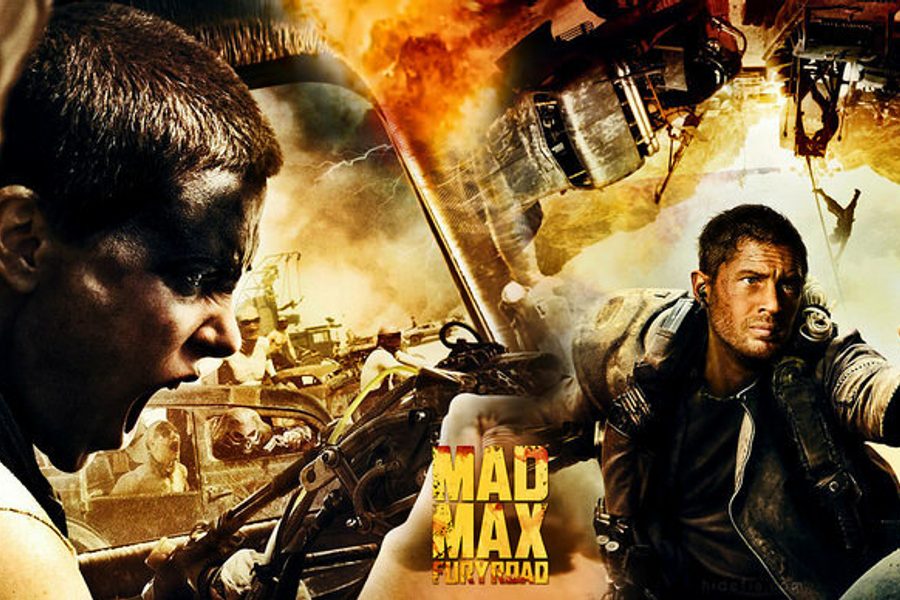Actually, Mad Max: Fury Road Isn’t That Feminist; And It Isn’t That Good, Either
Turns out the MRAs aren’t the best judges of feminism.
Eileen Jones

Men’s rights advocates (MRAs) have been creating big laughs on the internet for the past several days with posts fulminating about the way feminism has ruined the Mad Max franchise with Mad Max: Fury Road. Here’s a sample screed from Aaron Clarey, aka “Captain Capitalism”:
I’m angry about the extents Hollywood and the director of Fury Road went to trick me and other men into seeing this movie. Everything VISUALLY looks amazing. It looks like that action guy flick we’ve desperately been waiting for where it is one man with principles, standing against many with none.
But let us be clear. This is the vehicle by which they are guaranteed to force a lecture on feminism down your throat. This is the Trojan Horse feminists and Hollywood leftists will use to (vainly) insist on the trope women are equal to men in all things, including physique, strength, and logic.
Apparently, there’s a factual basis for claiming that Mad Max: Fury Road was designed to be a feminist film. Eve Ensler, the author of The Vagina Monologues, was hired by director George Miller to serve as a consultant, and she vouches for it: “I think George Miller is a feminist, and he made a feminist action film.”
To this end, Fury Road opens on a future-world that has regressed to a state of violent primitive patriarchy. This isn’t necessarily a bad premise, but it’s hammy as hell, with skull motifs festooning everything. It tries so hard to be dystopian it achieves inadvertent comedy instead. (When the desperate, ragged desert populace lines up for the ceremonial dispensing of water, all I could think was that the feature cartoon Rango did that scene a lot better.) Evil skull-masked overlord Immortan Joe (Hugh Keays-Byrne) rules The Citadel, a grim fortress built into red rock, where he holds a group of women captive as “breeders.” Led by Joe’s top truck driver, Furiosa (Charlize Theron), and aided by Max (Tom Hardy), the women escape, kicking off two hours of car chase.
Ensler was assigned to help the actors playing the women to better understand the experience of rape and captivity suffered by untold thousands of women who’ve survived war, sex slavery and epidemic levels of domestic violence worldwide. It should be noted that Eve Ensler isn’t exactly a universally acceptable choice as a model feminist. Though she does important work with women trauma survivors internationally, she’s also inclined to speak for them in dubious ways, as Tahira Khalid points out in her essay “Eve Ensler and the Inauthentic Monologue”:
I didn’t truly understand how Eve Ensler could imagine what it might be like to be a Bosnian woman during ethnic cleansing or a woman during the reign of the Taliban in Afghanistan. I don’t even know how Eve Ensler imagined a vocabulary or a language for these experiences that she hasn’t had.
Regardless of where one stands on Ensler’s feminist cred, I couldn’t see any evidence in the film of her consciousness-raising sessions. The first full shot we get of the escaping women shows them standing tall against a gorgeous sun-blasted horizon, wearing white muslin bikinis and other resort-wear, and looking exactly like supermodels posing for a Vogue shoot in the deserts of Namibia. Rose Huntington-Whiteley plays Splendid, the lead figure among the escaping band. The credentials that secured her this role are presumably her career highs as a top model, achieving the rank of a Victoria’s Secret “Angel” and a number one rating on Maxim magazine’s “Hot List” for 2011.
The other women are even less impressive performers. None can act in the least, but in addition to unmemorably pretty features, they have a broad spectrum of hair and skin colors, which is important when setting up a group Vogue shot in this enlightened age of ours.
That no primitive patriarch in his right mind would ever choose these particular women as “breeders” to keep his colony alive is immediately apparent. One of them is so thin and pale as to be almost transparent and looks as if she’ll die in a photogenic way at any second. But she could step onto any catwalk during Fashion Week, no questions asked.
Of course, Charlize Theron as Furiosa benefits from proximity to the supermodels who make her seem, by comparison, ferociously strong and a better actor than Meryl Streep. She’s tall enough to seem physically imposing, and she moves with athleticism. But she also brings with her the legacy of so many Dior perfume ads: the soft, tiny-nosed, blonde prettiness that her crew cut merely accentuates and that John Seale‘s lovely cinematography enshrines in innumerable close-ups. Just compare this example of onscreen feminism to Sigourney Weaver in Alien (1979). Weaver was six feet tall, odd, angular, smart and forceful, with highly individual, non-model looks and a remarkably ambitious actor’s resume, shot in unforgiving light and wearing a unisex worker’s uniform. In movies, we haven’t come a long way, baby.
We must also grapple with the supposedly feminist plot elements of Fury Road. The women’s escape from The Citadel is a quest to reach the matriarchal paradise where Furiosa was born. They repeat as a comforting mantra, “We’re going to the Green Place!” It’s the last stand of Mother Nature where, apparently, judging by the natives we eventually meet, no men ever lived.
It’s an extraordinary thing, in this day and age, that we still want to believe in a lot of essentializing Earth Mother nonsense about women. But apparently we do. In praising Fury Road, Eve Ensler says, “All the women in the film maintain their inherent woman-ness.”
Whatever “inherent woman-ness” is, I was afraid to find out. I dreaded getting to the “Green Place.” Would everyone be doing yoga when we got there? And communicating softly and understandingly with each other? Or perhaps tending gardens all day, then doing fertility dances by the light of the moon?
Eventually we meet some “spunky” old women from the Green Place. They’re huggy, but also ride motorcycles and talk tough. This is the comedic reversal of the clichés about endlessly nurturing women, but only gets us to another cliché: making older women unexpectedly and amusingly badass, like nice white-haired grandmothers suddenly cursing or break-dancing or singing hip-hop songs in Adam Sandler comedies. In Fury Road, the lead feisty old woman clutches a bag of symbolic seeds for future tending when they resurrect the Green World matriarchy somewhere else. What’s so annoying about these motifs is that they bring us to yet another cliché: “primitive” women as akin to Mother Earth, vessels for seedlings, awesome in their mysterious fertility. The film clearly considers the return to primitive patriarchy to be bad; I’m not sure why the regression to primitive matriarchy is supposed to be so terrific.
While I was watching the film, I thought with some bitterness, “It figures that they’d set out to make a ‘feminist action film’ and this would be the result.” I really regretted sitting where there was no nearby wall to beat my head against.
Of course, the majority of the audience wasn’t noticing any of that, because they were busy rhapsodizing over the action, which is indeed splendid. The “disguise” provided by the action was noted by Time magazine reporter Eliana Dockterman, in an interview with Eve Ensler:
It’s a sort of sneaky feminism. When you say the premise — a woman warrior escapes with female sex slaves — that doesn’t necessarily sound like a blockbuster. But because it’s an action film, guys will see it.
What if it’s not really feminism that’s been smuggled in, though, but only carloads of embarrassing stuff? Are we such action naïfs that we’re taken in by a lot of admittedly fantastic stunts? Can we really see no problems with this film at all? Does it make any sense that so many critics and fans are united in calling Fury Road “The Greatest Film of Its Kind Ever Made” and other wild encomiums?
Beyond the terrible pandering to supposedly feminist sensibilities, there’s the scourge of color grading that’s afflicting so many action films. Everything looks so beautiful in Fury Road that the menacing impact of Miller’s legendary dystopia is cut in half. Take a look at Mad Max 2: The Road Warrior (1981) and see the dead world leeched of color, pale sandy wasteland meets an ashen sky at the desolate far horizon, which is further obscured by heat haze. And the dust everywhere, including in the air, so that we seem to have grit in our eyes. It’s a world we’re meant to experience as implacably hostile.
Then look at Fury Road. Gorgeous color, red rock and rich umber sand against heartening blue sky, everything limpidly clear when we’re not actually moving into a dust storm (which is also too beautiful, like a lovely sculpted cloud formation moving along the ground). And the night is deep indigo spangled with stars! Walt Disney at his most sentimental — think the pastoral Technicolor nature scenes for Snow White and Bambi—couldn’t have tweaked the Fury Road color scheme to make it any prettier.
But I don’t want to see vacation resort landscapes right out of a glossy pamphlet when I watch a Mad Max movie. As David Christopher Bell notes in his Cracked article “6 Reasons Modern Movie CGI Looks Surprisingly Crappy,” one main reason is “Color grading makes everything look like a fantasy.” Omitting “realistic earth tones” and filtering grit and glare out of every image so that it looks like, in Bell’s words, “Middle-goddamn-Earth” is especially deleterious when it comes to dystopian science fiction film, with its built-in tendencies toward social criticism.
As for the action genre, its inheritance of aspects of film noir and the social problem film was evident in important early actions films such as Dirty Harry (1971) and Shaft (1971) and Walking Tall (1973) and the first Mad Max (1979), and sustained in many of the best films of the genre (First Blood, Terminator, Predator, Aliens, RoboCop, Die Hard, Bourne Identity, District 9). It’s a miserable development that the Mad Max franchise, famous for its harsh realist aesthetic, is suddenly made to look beautiful and fake.
The very few critics who’ve said a word against the film are mostly complaining about it for the wrong reasons. It’s got too much action, they say; it’s just one long chase scene.
But that’s what’s good about the film. In many interviews, Miller makes it clear that he set out to strip down the dialogue while expanding the chase scenes that formed the heart of the great Mad Max films. He’s compared his efforts to silent film, to John Ford’s epic chase scene in Stagecoach, to Hitchcock’s experiments in reliance on pure visuals.
This approach is perfectly in keeping with the logic of the devolved world Miller’s created, where a nightmarish scarcity of vital resources has forced people to hole up in the last oases and engage in desperate chases of human predator and prey.
But unfortunately Miller didn’t stick to his impulse to plane away excess; instead he’s combined the minimalist elements of what he’s called his “simple allegorical story” with excess at every level of execution. Even the wondrously choreographed stunting that keeps everything flying, flipping, careening, and cartwheeling in every direction starts to look like some demented Cirque de Soleil performance with a demolition derby theme after a while. Depth of field shooting is pushed to such an extreme that the director seems to be hunting for shots he can frame as comic book art, with an immense close-up of a face in one half of the screen repeatedly set off on the other half by flyspeck figures on the horizon ten miles back. It’s no surprise to find out that the famous comic-book artist Brendan McCarthy gets a co-writer credit with Miller and helped storyboard the film.
And any given face in close-up is likely to be lit as lovingly as a Rembrandt in a museum, and to be just on the verge of saying something of ponderous significance. There’s hardly any dialogue in Mad Max: Fury Road, but what’s there certainly weighs a ton. For example, when Furiosa tells Max what she seeks in escaping The Citadel, she intones, “Redemption.”
Big brooding delivery, big ravishing close-up, big heavy pause. I had the impulse to call out during that pause, “No, you don’t say that out loud! That’s SUBTEXT!”
And it makes no sense, either. What does Furiosa need redemption for? Getting abducted from her home as a child? Being a good truck driver? Helping other women? Max is the one who’s having the failure-flashbacks, so maybe that was supposed to be his line, or rather, his subtext.
All this emoting and signifying and extravagant visual lusciousness seems to constitute a new kind of popular Ham Art — overacted and overdone, and gleaming with meaty pinkness. And people eat it up. It’s a strange feeling to love action film and yet feel disappointed in what is apparently considered the greatest action film in a generation. And frankly, I admit I envy everyone who could enjoy the exhilarating chases along with the “Visit the Grand Canyon!” color scheme and the mortifying melodramatic poses and pauses, just because of the sheer genre film ecstasy I’m missing out on. But I can’t envy those who are embracing the dumb faux-feminism as well. That is pathetic, as well as unforgivable.

I hope you found this article important. Before you leave, I want to ask you to consider supporting our work with a donation. In These Times needs readers like you to help sustain our mission. We don’t depend on—or want—corporate advertising or deep-pocketed billionaires to fund our journalism. We’re supported by you, the reader, so we can focus on covering the issues that matter most to the progressive movement without fear or compromise.
Our work isn’t hidden behind a paywall because of people like you who support our journalism. We want to keep it that way. If you value the work we do and the movements we cover, please consider donating to In These Times.






